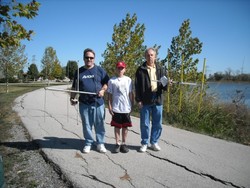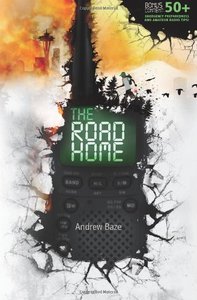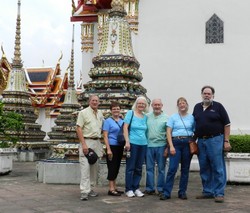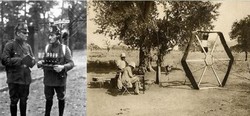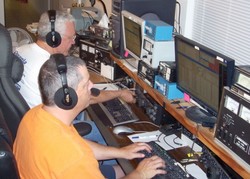 October 26, 2011 Editor: Ward Silver, NØAX | |||||||||
IN THIS ISSUE
NEW HF OPERATORS - THINGS TO DO The contest bands (160, 80, 40, 20, 15, and 10 meters) will be packed with DX and domestic stations alike during the big CQ World Wide SSB contest. Check your CQ Zone on this terrific map from Icom America (be sure to use CQ and not ITU zones) and jump right in - be prepared to enjoy higher bands that haven't presented sustained openings in a few years! Keep an eye on your transmit frequency to make sure that your carrier and sidebands are entirely within US operating privileges for your license class. BULLETINS Due to major flooding in Thailand and the recent large earthquake in Turkey, please avoid the following frequencies: 7.060-7.063 MHz (Thailand) and 7.092 MHz USB (Turkey). If asked to QSY to avoid interfering with emergency traffic, please do so immediately. BUSTED QSOS The weeknight date of the ARRL Frequency Measuring Test is Wednesday, Nov 9th, not Tuesday as reported in the QST announcement. (Thanks, Connie K5CM) In case there is any confusion about Technician privileges, Techs can operate CW from 28.0 to 28.5 MHz, SSB from 28.3 to 28.5 MHz, and RTTY/data from 28.0 to 28.3 MHz. (Thanks, Steve W3HF) CONTEST SUMMARY Complete information for all contests follows the Conversation section October 29-30
November 5-6
The CQ World Wide Contest's "Xtreme" category allows operation using Internet technology to extend traditional station definitions. The only requirement to enter in this category is that you must pre-register with the contest sponsors at Xtreme@cqww.com with a description of your proposed operation, information on your station, call sign to be used, operator list, and technology to be used. (Thanks, CQWW Xtreme Category Manager, Doug K1DG)
College club stations considering a weekend of Sweepstakes competition should take a look at WM5R's Collegiate Championship web site. Ken has compiled lists of category records and of winners by their NCAA conference participation - although there is a lot of rearranging going on these days. Take a look at your conference - wouldn't it be nice to post a winning score for your own? Don't forget, alumnii, you are allowed to operate with your alma mater's club as of last year! Another Sweepstakes change - this year's participants will be able to select either Low Power or High Power categories in both the Multi-Op and Unlimited categories. The "M" or "U" in the exchange will stay the same, but results (and awards) will recognize participants in each power category. Here's your chance to be on the record leader boards (until next year, anyway)! Take a look at this extensive article on CBS News commemorating today's 150th anniversary of completion of the transcontinental telegraph, the precursor of future technological revolutions such as telephone, teletype, fax, and Internet. (Thanks, Dave K6VML) A new web site for WRTC 2014 has been created through the hard work of Rudy N2WQ. It has been completely redesigned to look more professional and contain more information that will help competitors, visitors, and others as the preparations for WRTC 2014 continue. The WRTC 2014 web team is looking for help with graphic art design and article preparation. (Thanks, WRTC 2014 co-chair, Randy K5ZD)
Zac Manchester, a graduate student in Aerospace Engineering at Cornell University developed fingernail-sized satellites which may be deployed for Earth-orbit missions and could someday travel to Saturn. While fluttering down through the atmosphere, they will collect data about chemistry, radiation and particle impacts and transmit the information using a 10 mW radio on frequencies between 433 and 436 MHz. A group or club can sponsor a fleet of Sprites together as described on the Kicksat website. (Thanks, AMSAT Bulletin ANS-289 and Julius N2WN) Prasad VU2PTT reports that Indian amateurs can now use up to 400 W of transmitter final amplifier input power on all bands. This may help explain why the VU stations are so loud this weekend! Are you an "Asker" or a "Guesser"? Take a few minutes to read this article from The Guardian and consider the difference. (Thanks, Mark N5OT) A new release of the Super Check Partial database files is now available and be sure that your Country (CTY) files are up to date before this weekend's CQ WW contest. (Thanks, Bob WA1Z) The Tesla Conference 2011 is being organized by folks who work at Brookhaven National Laboratory with a goal of renovation of the Tesla's Wardenclyffe lab site as a museum/science center to further physics education and maintain the Tesla heritage. There will also be a special event station on Nov 5th using the call sign W3T. (Thanks, Jeff K1NSS) A new RTTY contest is coming to the bands on December 4th - check out the 10 Meter RTTY Contest, sponsored by Don AA5AU's rttycontesting.com and Ed WØYK's Muns Vineyard. It has the popular 24-hour format and with the bands so good lately, should attract a lot of participation on this first time out.
Web Site of the Week - I recently read an adventuresome novel for teens and young adults that features ham radio: "Road Home" by Andrew Baze AB8L. The story revolves around post-earthquake action in the Pacific Northwest and how ham radio plays an integral part in both emergency preparedness and personal survival. Instead of trying to explain all of the technology in the story, the author uses a limited number of footnotes and references to explain the terminology. I thought this was a good compromise to allow the interested reader to dive a little deeper into the technology. WORD TO THE WISE Peer pressure - there is no stronger remedy to ethical challenges in radiosport than the magical potion of a friendly word of advice or caution. It strengthens our community and makes better contesters of us all. Geoff KA1IOR took a few public logs from last year's CQ WW contest and created some interesting visual analysis by using PERL scripts. The charts illustrate some winning techniques and will help the reader learn what strategies are important. What to do with surplus TVRO dishes? A group of four students at the University of Cincinnati set a world's record for point to point communications on 2.4 GHz at the Las Vegas WiFi Shootout in 2005. I wonder if they could see the neighbor's network, too? (Thanks, Hank N8XX)
Dan K7SS suggests the air hockey documentary "Way Of the Puck" currently being seen on PBS stations as a parallel to ham radio contesting. As its devotees find, the bug bites hard and stays for life! Everybody loves autonomous flying robots! There is lots of cool stuff going on with quadrotor platforms, such as this juggling video. Now, can we get them to haul the antenna rope over that super-tall tree? (Thanks, Bob N6TV) If you missed seeing the aurora borealis this past Monday evening, you can get a sense of it from this NASA Earth Observatory photo, story, and time-lapse video from late September. Why is 73 the best number? The cast of "Big Bang Theory" explains in this video. (Thanks, Andy N2NT) ARRL Contest Branch Manager, Sean KX9X reports that the 2010 ARRL Sweepstakes plaques and Phone Sweepstakes certificates have all been mailed along with the 2010 160 Meter Contest certificates. Don't forget you can always check on ARRL contest awards processing online. Speaking of online, that's where you can find the 2011 Field Day results, too! The final results of the CW part of the 2011 Scandinavian Activity Contest were delivered to the webmaster together with a brief write-up. You can also get your log-check results before all of them are on-line by emailing oh6kzp@sral.fi. Work is now proceeding on the more than 1050 SSB logs! (Thanks, SAC Committee Member, Kim OH6KZP)
Results for the 2011 UBA DX SSB Contest are now available. The database is being updated with older results, too - back to 2006. (Thanks, Franki ON5ZO) The results for the first ever Summer Stew Perry Top Band Distance Challenge have been posted. Congrats to Herb KV4FZ, who narrowly beat Ty NO3M for first place. (Thanks, Tree N6TR) Barry W2UP reports that the latest High-Speed Morse Competition is now over. Barry snared a bronze medal in RUFZ and a gold in Morserunner. The US team placed tenth. The 2011 CQ WPX Contest survey results have been published as Part 1 and Part 2. Nearly 4950 respondents answered the survey questions about operating style, combining Single-Op and Single-Op, Assisted categories, and other topics. Contest Director, Randy K5ZD also notes that everyone who submitted a log for the WPX SSB Contest 2011 has been sent an email with a link to their log checking report. If you did not receive your report, please contact Randy. OPERATING TIP Voice maintenance - to keep your voice in good shape during a long contest, learn to speak clearly at a comfortable level without shouting. It helps to practice with a friend on the air in setting your mic gain and compression levels properly. If you use voice recordings, take steps to reduce the amount of background noise in them and try to match your normal speaking voice settings for clean transmitted signals. (And watch that VFO frequency when clicking on a spot - it's easy to not notice that the frequency is outside your operating privileges or too close to a band edge.) With power output an important part of complying with contest rules and national regulations, remember that net power flow in a transmission line is the difference between the power flowing in each direction. Net forward power is what most contest rules refer to as "output power". On most directional wattmeters such as the Bird 43 series, net forward power is computed by subtracting the value of reflected power headed towards the transmitter from the value of forward power (which includes both power supplied by the transmitter plus any reflected power that is re-reflected at the transmitter). The forward power reading in such a wattmeter thus varies with SWR. The two power readings are nearly independent with about -30 dB isolation between the two in a well-designed wattmeter. (A "smart" wattmeter may do that subtraction for you.) To run the output of an amplifier into more than one antenna, you'll need a power splitter. Stack switches such as those made by Array Solutions and Microham can do the job using transmission line techniques.
F-type connectors are becoming more popular in amateur use for receive antennas and other jobs. While the most common style for equipment chassis mounting is a threaded, single-nut connector, a four-hole flange-style connect also exists - Mouser Electronics part number 161-9126. (Thanks, Mike WØBTU) If you know what cables will be in a run of conduit, an alternative to pulling them through the finished run is to lay them out next to the trenches and slide the conduit sections into place over the cables. Then glue the sections together as you lay them into the trenches. You can include a pull rope in to the bundle for future use. Make sure the conduit joint surfaces are completely clean before gluing. This might not be practical for very long runs of conduit, though. (Thanks, Alan K9MBQ) In you live in a windy area, static can build up on an antenna to disturbingly high voltages. An RF choke across the feed line will allow static to bleed off, but a high-value (10k or higher) non-inductive resistor with a 2 to 5-watt dissipation will do the job without self-resonances in the HF region. Metal-oxide resistors available from several vendors will work well Connect the resistor across the feed line by using a tee-connector (coax) or at the terminals (parallel-conductor). A year ago Jim K1TN bought a new Weller soldering gun and couldn't figure out why a lot of the time it wouldn't put out enough heat. Recently, whilst soldering an antenna outdoors, he realized, in a blaze of neural activity, that the first detent of the trigger is HIGH and the second, all-the-way-in position is LOW. The natural tendency to squeeze harder for higher heat is defeated by this configuration! Technical Web Site of the Week - Log-periodic designers can make good use of Roger WBØDGF's LPCAD calculator. Roger has recently released version 3.40 and it makes short work of creating a log-periodic dipole array design. Roger's site also offers numerous other useful antenna links and items. (Thanks, Jake K9WN) Notes on CQ World Wide The largest sporting event no-one outside ham radio has ever heard of, CQ World Wide SSB with its nearly 30,000 participants, is coming to a band near you this weekend. As you listen to the world turn, be sure to compete exhibiting the best ham spirit! Contest Director, Bob K3EST recently posted a few thoughts about operating: "Many competitors enter a contest to compete for a top spot in their country, continent or the world. In is very important for all of us to promote fair play in contesting. Fair play is addressed with the Contester's Code of Ethics and the Contest University lecture on ethics by Doug K1DG:
- I will learn and obey the rules of any contest I enter, including the rules of my entry category - I will not modify my log after the contest by using additional data sources to correct call sign or exchange errors. Both points are of high importance to ensure a fair contest. The first point includes running the power allowed by your chosen category. An entrant may run the maximum power allowed by their chosen category:1500, 100 or 5 watts. All high power categories must not exceed 1500 watts total output power on any band at any time. You cannot run 1500 watts to each antenna on a band. "Although the second point addresses what occurs after the contest, the CQ WW Contest Committee considers it unsportsmanlike to "clean" your log post-contest using data sources such as recordings, call sign databases, etc. "If you enter any Single-Operator category, you are allowed only one signal on the air at any time. If you enter any multi-operator category, you are allowed only one signal on a band at any time. How do you prevent two signals on a band at the same time? Several "lockout" solutions have been provided to the CQ WW Contest Committee and are available under RESOURCES on the CQ WW contest website. "When should you should claim to be in the Single-Op, Assisted category? Ask yourself the following question: Did you have help finding the call sign of any QSO in your log? If the answer is yes, you should enter as Single-Operator, Assisted. (This does NOT refer to receiving other types of physical assistance - Ed.) If you have any questions concerning when to claim assisted, please contact the CQ WW Committee. "Clubs worldwide can help promote FAIR PLAY in contesting. The CQ WW Contest Committee has endorsed the Contesters Code of Ethics created by the World Wide Radio Operators Foundation. Both of these sources can be used to create a club program concerning ethics/FAIR PLAY. If your club needs help developing a program, please contact the CQ WW Contest Committee. Let's try again to make it clear -- Have fun! Fun is what it is all about! Lots of activity and countries equals lots of fun!" On a related topic, with conditions having improved so dramatically on the upper HF bands in recent weeks, there will be a lot of activity across the entire spectrum in this weekend's CQ World Wide SSB contest. What if you want to enjoy all of that action but submit your log in a single-band category? Don't remove any QSOs from the log - just be sure that your Cabrillo format header contains a line beginning with "CATEGORY-BAND:" followed by 160M, 80M, 40M, 20M, 15M, or 10M. (You can view and revise your log with any text editor but be sure to save it as plain text.) All of your QSOs will be used for log checking but only QSOs from your single-band submission will count for your score. If your logging software generates the older Cabrillo 2.0 format, make sure the header line for category looks like the following example for a 20 meter, single-band entry. CATEGORY: SINGLE-OP 20M HIGH PHONE
If you want a separate all-band score to count for your club, add a note stating that in a SOAPBOX: line in the log header and be sure to spell your club name correctly as listed on the CQ WW Club Names web page. While you're reviewing your log, make sure the header information is all correct and that each QSO contains the correct information for your exchange. After you submit your log to the CQ WW contest robot at ssb@cqww.com, you will receive an emailed response - read it! Be sure the robot's message correctly reports the category, number of QSOs, and so forth. If any of these are incorrect or the robot reports a problem, edit your log and resubmit it until everything is accepted properly. There will be a submitted logs report published on the CQ WW website as logs come in - be sure yours is listed and in the right category. Don't wait until next fall to find out there was a problem! 25 October through 8 November An expanded, downloadable version of QST's Contest Corral in PDF format is available. Check the sponsor's Web site for information on operating time restrictions and other instructions. HF CONTESTS CQ World Wide SSB Contest--Phone, from Oct 29, 0000Z to Oct 30, 2359Z. Bands (MHz): 1.8-28. Exchange: RS and CQ zone. Logs due: Nov 21. Rules ARRL November Sweepstakes--CW, from Nov 5, 2100Z to Nov 7, 0300Z. Bands (MHz): 1.8-28. Exchange: Serial, category, call, check, ARRL sec. Logs due: Nov 22. Rules Collegiate ARC Championship--CW, from Nov 5, 2100Z to Nov 7, 0300Z. Bands (MHz): 1.8-28. Exchange: See ARRL Sweepstakes. Logs due: Nov 22. Rules SKCC Weekday Sprint--CW, from Oct 26, 0000Z to Oct 26, 0200Z. Bands (MHz): 1.8-28, 50. Monthly on the fourth Wednesday local time. Exchange: RST, S/P/C, name, SKCC number. Logs due: 2 days. Rules ARS Spartan Sprint--CW, from Nov 1, 0200Z to Nov 1, 0400Z. Bands (MHz): 3.5-28. Monthly on the first Monday evening local time. Exchange: RST, S/P/C, and power. Logs due: 2 days. Rules SNS and NS Weekly Sprints--CW, from Nov 4, 0200Z to Nov 4, 0300Z. Bands (MHz): 1.8-14. Weekly on Thursday evenings local time. Exchange: Serial, name, and S/P/C. Logs due: 2 days. Rules Ukranian DX Contest--Phone,CW, from Nov 5, 1200Z to Nov 6, 1200Z. Bands (MHz): 1.8-28. Exchange: RST and serial or Ukraine oblast. Logs due: 30 days. Rules Radio Club of America QSO Party--Phone, from Nov 5, 1700Z to Nov 6, 0500Z. Bands (MHz): 3.5-21. Exchange: RST, QTH, name, equipment. Rules DARC 10-Meter Digital "Corona"--Digital, from Nov 6, 1100Z to Nov 6, 1700Z. Bands (MHz): 28. Exchange: RST and serial. Logs due: 2 weeks. Rules VHF+ CONTESTS Fall VHF Sprints--Phone,CW,Digital, from Oct 29, 2300Z to Oct 30, 0300Z. Bands (MHz): 50. Exchange: 4-character grid square. Logs due: 4 weeks. Rules SKCC Weekday Sprint--CW, from Oct 26, 0000Z to Oct 26, 0200Z. Bands (MHz): 1.8-28, 50. Monthly on the fourth Wednesday local time. Exchange: RST, S/P/C, name, SKCC number. Logs due: 2 days. Rules LOG DUE DATES 25 October through 8 November
ARRL Information Click here to advertise in this newsletter. Your One-Stop Resource for Amateur Radio News and Information ARRL membership includes QST, Amateur Radio's most popular and informative journal, delivered to your mailbox each month. Subscribe to NCJ - the National Contest Journal. Published bimonthly, features articles by top contesters, letters, hints, statistics, scores, NA Sprint and QSO Parties. Subscribe to QEX - A Forum for Communications Experimenters. Published bimonthly, features technical articles, construction projects, columns and other items of interest to radio amateurs and communications professionals. Free of charge to ARRL members: Subscribe to The ARRL Letter (weekly digest of news and information), the ARES E-Letter (monthly public service and emergency communications news), Division and Section news -- and much more! ARRL offers a wide array of products to enhance your enjoyment of Amateur Radio. Visit the site often for new publications, specials and sales. Donate to the fund of your choice -- support programs not funded by member dues! ACKNOWLEDGEMENTS ARRL Contest Update wishes to acknowledge information from WA7BNM's Contest Calendar and SM3CER's Contest Calendar. | |||||||||

